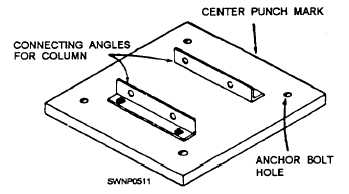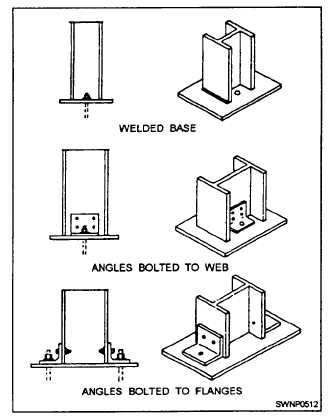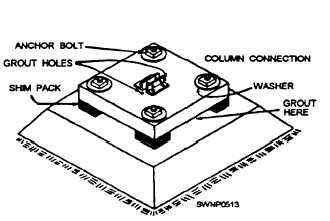anchor bolts (fig. 3-7). The holes should be slightly larger than the bolts so that some lateral adjustment of the bearing plate is possible. The angle connections, by which the columns are attached to the bearing plates, are bolted or welded in place according to the size of the column, as shown in figure 3-8.
After the bearing plate has been placed into position, shim packs are set under the four comers of each bearing plate as each is installed over the anchor bolts, as shown in figure 3-9. 'The shim packs are 3- to 4-inch metal squares of a thickness ranging from 1 1/6 to 3/4 inch, which are used to bring all the bearing

Figure 3-7. - Column bearing plate.

Figure 3-8. - Typical column to baseplate connections.

Figure 3-9. - Leveled bearing plate.
plates to the correct level and to level each bearing plate on its own base.
The bearing plates are first leveled individually by adjusting the thickness of the shim packs. This operation may be accomplished by using a 2-foot level around the top of the bearing plate perimeter and diagonally across the bearing plate.
Upon completion of the leveling operation, all bearing plates must be brought either up to or down to the grade level required by the structure being erected All bearing plates must be lined up in all directions with each other. This may be accomplished by using a surveying instrument called a builder's level. String lines may be set up along the edges and tops of the bearing plates by spanning the bearing plates around the perimeter of the structure, making a grid network of string lines connecting all the bearing plates.
After all the bearing plates have been set and aligned, the space between the bearing plate and the top of the concrete footing or slab must be filled with a hard, nonshrinking, compact substance called GROUT. (See fig. 3-9.) When the grout has hardened the next step is the erection of the columns.
COLUMNS
Wide flange members, as nearly square in cross section as possible, are most often used for columns. Large diameter pipe is also used frequentl y (fig. 3-10), even though pipe columns often present connecting difficulties when you are attaching other members. Columns may also be fabricated by welding or bolting a number of other rolled shapes, usually angles and plates, as shown in figure 3-11.
If the structure is more than one story high, it may be necessary to splice one column member on top of another. If this is required, column lengths should be
Continue Reading